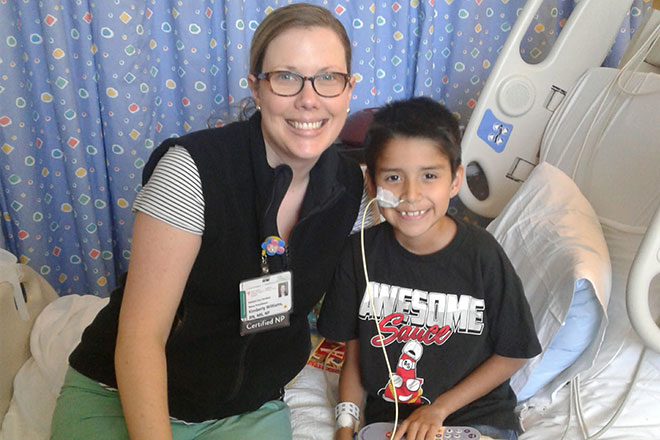Isaac Guajardo, 9-years-old
“Victory day!” was the last thing Isaac Guajardo’s family heard him say as he was wheeled into surgery to receive his new heart on April 14, 2018. At just 9 years-old, it was the fifth open heart surgery Isaac was undergoing in less than three years. But he knew this one was different.
Isaac was born with Marfan syndrome, a connective tissue disorder that is associated with cardiovascular risks. He is the third generation in his family with this disease; his father and grandfather were also born with it. As Isaac grew older, he began presenting signs of a weakening heart and at age six, he began a complex series of heart surgeries to repair his organ. His first open heart procedure was a valve-sparing aortic root replacement in January 2016. A year later, a second surgery was required to replace his still weakening valve with a metal valve. Soon after, a left coronary artery became blocked and Isaac was life flighted to Lucile Packard Children's Hospital Stanford for emergency a coronary artery bypass graft. He recovered well from that surgery and returned home to Tulare, CA. But a few months later, Isaac began experiencing cardiac troponin leaks—often a precursor to heart attack. He returned to Packard Children’s for the second time, where doctors surgically placed an implantable cardioverter defibrillator (ICD) in his chest—a device that delivers an electrical shock to restore a normal heart rate if it detects an irregular heartbeat.
But even this was not enough to repair the damage to Isaac’s heart caused by his coronary artery block the year prior. “It became hard for him to do small things, like walk a mile, and then a half mile,” remembered his mother, Samantha. Eventually, he was no longer able to climb stairs without feeling winded and light headed. Without a heart transplant, doctors did not believe Isaac would survive, and he was added to the transplant list on July 13, 2017.
Doctors at Packard Children’s worked closely with the Guajardo family on a care regiment that allowed him to return home to Tulare, CA while they waited for the call that a match was available for Isaac, knowing that in many cases, this can take many months. He attended school during the first half of third grade wearing a feeding tube and milrinone drip—a medicine used to support blood pressure in patients with heart failure. He held an info session for his teachers at the beginning of the school year where he explained the tubes attached to him, and what it meant to be on the heart transplant list. “He told them that it wasn’t scary, and that it was ok to have questions if they wanted to ask him anything,” Samantha explained. “He was really positive about it.”
As the weeks passed, Isaac showed increased signs of heart failure. Two days after his 9th birthday while at a farmer’s market with his family, he felt chest pains and shortness of breath. He was taken to a nearby children’s hospital, and then life flighted once again to Packard Children’s. Doctors made the decision to admit him and keep him in the hospital until a transplant became available.

Four weeks later on April 13, 2018, the call came: a heart was available! Isaac’s parents, siblings and extended family came to the hospital. His cousin, a minister, prayed with him and told him “today is your victory day,” Samantha remembers. Thus began his cheer. “He went into surgery so positive.” In addition to a heart transplant that day, doctors performed a pectus repair to correct his anterior chest wall—a common condition in people with Marfan syndrome—by inserting a metal bar into Isaac’s chest.
Less than a month after his surgery, Isaac was discharged from the hospital. The family stayed nearby in the Ronald McDonald House at Stanford while he received ongoing monitoring at the hospital, and they were able to return home to the Central Valley, 200 miles away from the hospital, in July.
Now, “he can run, jump and says ‘mom, I can do the stairs again!” Samantha said. There wasn’t just one victory day for Isaac. “With his new heart, there are little victories for him every day,” she added.
And it has been more than a physical transformation for Isaac, who returned to school for fourth grade in mid-August. A few weeks after his procedure, Isaac had the rare opportunity to see his old heart in the Stanford pathology lab. He was shown a healthy heart compared to his old heart, with scars from each prior surgery visible. “I didn’t realize how sick I was until I saw my old heart,” he told his mom.
“I thought that was really grown-up of him to say. He has matured so much throughout this process,” Samantha said. “Isaac’s journey taught us all as a family a lot. We’ve never lost hope. We questioned a lot, but it all worked out. We’ve all grown so much, especially because he had such a good outcome.”
Connect with us:
Download our App: